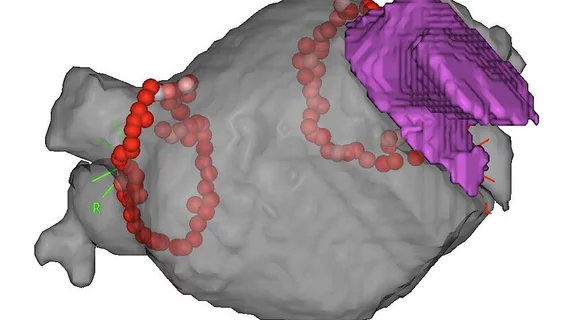High power vs. standard RF ablation leads to improved pulmonary vein isolation, shorter procedures
The Short-AF Study data presented as a late-breaking study at Heart Rhythm 2022 found a 96% percent freedom from reoccurrence of atrial fibrillation (AFib) in patients treated with high power vs. standard power radiofrequency (RF) ablation for pulmonary vein isolation (PVI). The researchers also found a 39-minute average reduction in time to PVI using high energy.
PVI procedures can take a long time and researchers at the University of California San Francisco (UCSF) and The Alfred in Melbourne, Australia, used this study to test outcomes in high powered RF ablations in the EP lab. The hope was it would better isolate the pulmonary vein and prevent the reoccurrence of AFib in the patient.
Researchers found using higher energy was able to gain better lesion contiguity and faster procedure times without compromising patient safety.
The study found high-powered ablation shortened PVI times with from an average of 126 minutes down to 87 minutes, explained Adam Lee, MBBS, an electrophysiologist at UCSF, one of the lead authors of the study.
There was a greater freedom from recurrent AF with high power, which showed 96% of patients did not have recurrence and were off of anti-arrhythmic agents by the end of the study.
There were no pericardial effusions, phrenic nerve injury or atrio-esophageal fistulae in either group. No clinical strokes or TIAs were observed.
However, Lee said there was a trend towards a higher incidence of post-procedure cerebral emboli observed on MRI in the high power patient arm, 40% vs. 17%.
Lee concluded that high power (50W) as compared to standard power (30W/25W) radiofrequency ablation results in reduced procedure time and there is a greater freedom from atrial arrhythmias at 12 months.
There were 29 patients in the high power arm and 31 in the standard power arm. Key inclusion criteria included 18 or older with paroxysmal or persistent AFib and no prior AFib or LA ablation. Exclusion criteria included persistent AF for more than 1 year, stroke/TIA within prior 6 months, LV ejection fraction below 35% and any implanted pacemaker, ICD or other MRI contraindication.
More coverage from Heart Rhythm 2022, the annual conference hosted by the Heart Rhythm Society, is available here and here.

